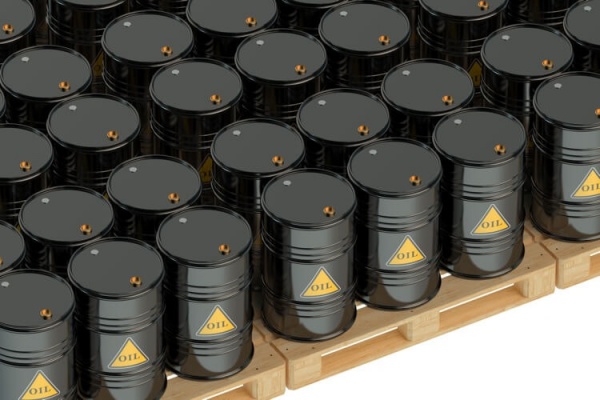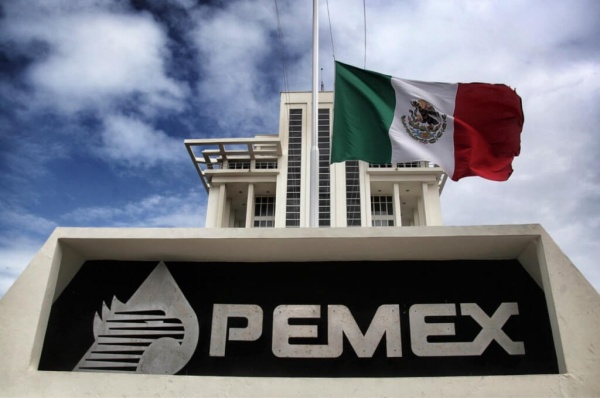by Sheela Tobben and Amy Stillman
“Shipments of crude to the U.S. from Mexico fell to a new low last week, extending a trend that go back to when the Energy Information Administration began compiling preliminary weekly import data in June 2010.
Imports totaled 290,000 barrels a day in the week ended April 14, a 43 percent weekly drop that may have been triggered by weather-related closings at Mexico’s key export ports this month. But the shipments have been sinking for years. The 52-week average through April 14 was 561,000 barrels a day, down from about 630,000 a year earlier.
“The latest import levels are continuing a long trend,” Court Smith, director of research with shipbrokers MJLF & Associates, said by instant message from Stamford, Connecticut. “This is because of a combination of recent rise in refinery rates and historically declining production in Mexico.”
Production in Mexico has declined for 12 years in a row and this year will be less than 2 million barrels a day, the lowest level since 1980, according to Petroleos Mexicanos, the state producer, hurting sales of the benchmark Maya heavy crude.
“Pemex’s six refineries are also using more of the crude, lessening the need for exports. They processed 930,400 barrels a day in February, the most since June of last year, according to Mexico’s Energy Information Agency. The company expects to raise rates further to boost gasoline supply in the near term.
Refiners on the U.S. Gulf Coast, which are the primary users of Mexican crude, have been turning north for supplies, said Andy Lipow, president of Lipow Oil Associates, a Houston-based consulting company. Canadian imports averaged 3.16 million barrels a day over the 52 weeks through April 14, up from about 3.02 million a year earlier.
“Canadian crudes are making more headway into the U.S judging from the full pipes coming down from Canada,” Lipow said by phone Friday. “We do expect to see more heavy crude from Canada when projects like Suncor Energy Inc.’s Fort Hills mine come online toward end of the year.”
Mexico has increasingly turned to Europe and Asia to make up for the U.S. demand shortfall. While overall Mexican crude exports fell in the first half of April, sales to Spain have increased since February, according to estimates from vessel-tracking and U.S. bills of lading data compiled by Bloomberg oil-market specialist Bert Gilbert. Exports to India, South Korea, Japan and China also grew in February, Mexico customs data compiled by Bloomberg show.
“While U.S. Gulf refineries were in maintenance, heavy crude oil producers have had to send their shipments to other regions, such as Asia, where heavy crude has recently strengthened thanks to the OPEC cut,” said Ixchel Castro, an analyst at Wood Mackenzie in Mexico City. “Greater shipments of Maya to Asia allows Pemex to achieve better margins for its exports.”
Mexico crude imports may pick up as gasoline demand rises for summer and refinery maintenance ends, Castro said in an emailed response to questions.
“This is the season where we would normally expect more heavy crude imports for U.S. Gulf Coast coking plants,” she said.
Pemex didn’t respond to requests for comment.”
21 de abril de 2017 16:05 GMT-5 updated 22 de abril de 2017 6:00 GMT-5

Reporting by Adriana Barrera, Additional reporting by Alexandra Editing by Dave Graham and and Peter Cooney
“Mexican state-run oil company Pemex plans a second deepwater “farm-out” joint venture in the Maximino and Nobilis areas in the Gulf of Mexico where super light crude has been found near the U.S. border, two people familiar with the matter said.
Speaking this week, the people said Pemex [PEMX.UL] would likely seek approval in June from the National Hydrocarbons Commission, or CNH, the industry regulator, to launch a tender for partners with the aim of announcing a winner in December.
“Maximino-Nobilis may be assigned in December and we hope the CNH will announce it in June,” said one of the sources. The people spoke on condition of anonymity because the plans are not yet public.
A Pemex spokesman said the firm was looking for a partner to develop Maximino and Nobilis, and that the proposal would be submitted for approval by the board in the next few days. The CNH would then need to decide on the time frame, he added.
The farm-outs are a central pillar of the government’s efforts to lure investment to Mexico since Congress opened up the country’s long-closed oil and gas industry to private investment in a legislative drive between 2013 and 2014.
Under the farm-outs, Pemex cannot choose which company would help it develop each project. The ultimate decision lies with the CNH following a round of competitive bids.
The process allows Pemex to share the risks and rewards of expensive deepwater oil development projects.
Australian mining and energy company BHP Billiton (BHP.AX) in December won the right to partner with Pemex in the first deepwater farm-out for the Trion light oil field, less than 50 miles (80 km) from the U.S.-Mexico maritime border.
A separate, shallow water farm-out auction for the Ayin-Batsil field is due to take place in October.
Pemex has sunk two wells in Maximino at a depth of 3,000 meters (9,840 feet), discovering super light crude.
In September 2016, Pemex said it had found super light crude in its Nobilis-1 well, also at some 3,000 meters.
Both areas lie in the Perdido fold belt, like Trion.”
Thu Apr 20, 2017 | 6:57pm EDT

“Crude oil recouped earlier losses on Monday in subdued trading, but signs that the United States is continuing to add output largely counteracted strong economic growth in China and OPEC-led efforts to cut production.
Benchmark Brent crude futures were down 14 cents at $55.75 at 1350 GMT, after trading as much as 58 cents lower.
U.S. West Texas Intermediate (WTI) crude futures were down 14 cents at $53.04 a barrel, after falling by as much as 55 cents earlier in the day.
Both benchmarks rose last week for a third consecutive week, and were trading close to 12 percent above their 2017 lows. Speculators in the week to April 11 also increased their bets on bullish performance in both contracts.
But in thin trading due to holidays across Europe, the focus was on indications that shale oil output in the United States was creeping higher.
“All the signs of an ever-growing bull market are starting to fade away, (with) Libya and geo-political tensions easing, but also because the Texans are back and they are pumping like there’s no tomorrow,” said Matt Stanley, a fuel broker at Freight Investor Services (FIS) in Dubai. “If I were OPEC, I’d be pretty worried.”
Although the failure of a ballistic missile launch in North Korea brought some respite, markets were braced for further tensions in the region.
In Libya, fighting between rival factions has cut oil output, but state oil company NOC was able to reopen at least one field and was pushing to reopen another.
U.S. drillers last week added rigs for a 13th straight week, bringing it to its highest in roughly two years. Investors are also pouring money into the industry, suggesting U.S. output gains will continue. <RIG/U>
“Increasing U.S. output is undermining attempts by the Organization of the Petroleum Exporting Countries and other major oil producers to curb output and sustain a price rally in a market that has been oversupplied since mid-2014.
While Iran fueled hopes that OPEC and non-OPEC oil producers could extend their output cuts beyond the six-month agreement, Saudi energy minister Khalid al-Falih said it was too early to discuss an extension.
U.S. crude oil production reached 9.24 million barrels per day (bpd), according to the latest Energy Information Administration data, making it the world’s third-largest producer after Russia and Saudi Arabia.
The increasing production largely counteracted figures showing first-quarter economic growth of 6.9 percent in China. Forecast-beating March investment, retail sales and exports all suggested China’s economy, the world’s second-largest oil consumer, may carry solid momentum into spring.
China’s March refinery throughput also rose to 11.19 million bpd, just shy of December’s record, as margins remained attractive.”
By Libby George / REUTERS
Mon Apr 17, 2017 | 10:03am EDT

“Most oil producers support an extension of output cuts by OPEC and non-OPEC countries, and Iran would also back such a move, Iranian Oil Minister Bijan Zanganeh was quoted as saying.
“(Zanganeh) stressed that most countries want OPEC’s decision to be extended,” the Iranian Students’ News Agency (ISNA) reported.
“Iran also supports such a decision and if others comply, so would Iran,” Zanganeh told reporters late on Saturday, according to ISNA.
The market has been oversupplied since mid-2014, prompting members of the Organization of the Petroleum Exporting Countries and some non-OPEC producers to agree to cut output in the first six months of 2017.
OPEC meets on May 25 to consider extending the cuts beyond June. Saudi Arabia, Kuwait and most other OPEC members are leaning towards this if agreement is reached with other producers, OPEC sources told Reuters last month.”
Reporting by Dubai newsroom; Editing by Sandra Maler / REUTERS

“Mexico’s peso won’t return to the record lows it reached this year even if the U.S. makes good on threats to undo the trade agreement that transformed Latin America’s second-largest economy into an export powerhouse, according to the currency’s top forecaster.
The selloff that sent the peso plunging to 22 per dollar in the days before Donald Trump’s inauguration was overdone despite the threat to Nafta, said Scott Petruska, a foreign-exchange adviser for Silicon Valley Bank who was the most accurate analyst in the first quarter according to Bloomberg rankings. He correctly predicted that the currency would recover from the rout to become one of the best performers in the world this year.
“The Trump administration seems to have Mexico in its cross hairs which makes everybody very nervous, whether it’s negotiating Nafta or slapping some sort of tariff or border tax on imports from Mexico,” Petruska, who was also the top forecaster for Canada’s dollar, said from Boston. “But we can appreciate that Mr. Trump’s bark is often times worse than his bite.”
The peso plunged 15 percent from Trump’s surprise election win to when he took office as investors speculated he would damp foreign investment and suppress exports to the U.S., the destination for 75 percent of the goods Mexico sends abroad. It erased some of those losses in the first quarter as the central bank raised interest rates and U.S. officials indicated they probably wouldn’t seek to scrap Nafta entirely. Mexico central bank Governor Agustin Carstens said Wednesday that the peso — at about 18.8 per dollar — is still undervalued.
Petruska sees the peso weakening to 20 per dollar by September as traders overreact to whatever trade negotiations get underway, but says it will quickly recover to trade at 19 by the end of the year. The currency will gain to 18.3 per dollar by the end of 2018, he said.
With a benchmark lending rate of 6.5 percent, Mexico offers a higher return on local bonds than peers such as India, Peru and Chile. Volatility in the peso, meanwhile, has plummeted in the last few months and “speculators will feel comfortable going into the carry trade,” Petruska said.”
by Isabella Cota / Bloomberg
6 de abril de 2017 4:00 GMT-5

“Summer may be a few months away but oil investors are already getting their hopes up that American drivers will do their part to rebalance the market.
Hedge funds increased bets on higher West Texas Intermediate crude prices for the first time in six weeks, shrugging off rising U.S. supplies, as the coming driving season is expected to help ease the glut. Their wagers on more expensive gasoline jumped the most since last year, U.S. Commodity Futures Trading Commission data show.
U.S. fuel producers typically boost crude processing at this time of year as they prepare for the summer surge in demand. In a sign that they’ve already started, a government report showed refineries operating at the highest rate in about three months. Foreign refiners are also developing a taste for American barrels. Crude exports rose to a record in February as China displaced Canada as the biggest customer, Census Bureau data showed.
“As refinery utilization picks up, and if crude exports to Asia remain high, crude supplies will start to deplete,” Thomas Finlon, director of Energy Analytics Group LLC in Wellington, Florida, said by telephone. “The market is focused on where the market is heading, not where it’s been, and crude supplies are going to be whittled down.”
Money managers’ WTI net-long position, or the difference between bets on a price increase and wagers on a drop, climbed 9.2 percent in the week ended April 4 after tumbling 41 percent in the prior five weeks, according to the CFTC. Net bullish bets on gasoline climbed 59 percent, the biggest increase since December.
Refining Boost
Gasoline and diesel producers used 90.8 percent of their crude-processing capacity in the week ended March 31, the most since Jan. 6, according to the Energy Information Administration. Meanwhile, gasoline inventories have fallen almost 8 percent since mid-February, to 239.1 million barrels.
“Bigger-than-expected draws in gasoline stocks help explain the big gain in gasoline net length,” Tim Evans, an energy analyst at Citi Futures Perspective in New York, said by phone. “It probably helped boost interest in WTI.”
Oil futures touched an 18-month high on the first day of trading this year as an accord between the Organization of Petroleum Exporting Countries and 11 other producers to cut output for six months came into effect. Six members of OPEC and Oman back extending production curbs beyond June, with Saudi Arabia and Kuwait saying oil stockpiles need to fall to the five-year average.
The outlook for an extension of the accord has also helped renew optimism that prices will rebound, according to Michael Lynch, president of Strategic Energy & Economic Research in Winchester, Massachusetts.
Bears Retreat
“The oil bears were in retreat because OPEC appears to be complying pretty well to the quota and the likelihood that the cuts will be extended,” Lynch said by phone.
The net-long position in WTI rose by 22,415 futures and options to 267,030. Longs advanced 2.3 percent, while shorts retreated 12 percent. WTI rose 5.5 percent to $51.03 a barrel in the report week. The U.S. benchmark crude was trading at $52.59, up 0.7 percent, at 9:47 a.m. London time on Monday.
Gasoline futures increased 5.3 percent to $1.7217 a gallon in the report period. The May contract was trading at $1.7486 on Monday, extending gains from the highest close for front-month prices since August 2015.
“Gasoline is a safe place to hang your hat as summer approaches,” Energy Analytics’ Finlon said. “Crude supplies will fall as utilization ramps up to meet gasoline demand.”
9 de abril de 2017 18:01 GMT-5

“Petroleos Mexicanos has identified Japanese trading company Mitsui & Co. and South Korea’s SK Engineering & Construction as among potential partners for a $2.1 billion project at the company’s Tula refinery which will turn lower-value fuel into products like gasoline and diesel.
Others that may participate in the joint venture to develop and operate the coker unit at Tula include PetroChina Co., China’s largest oil producer; China Petroleum & Chemical Corp., known as Sinopec; Royal Dutch Shell Plc and Chevron Corp., according to a spokesman who couldn’t be identified because of company policy. Pemex will ask for formal bids in the next few weeks, said a person with knowledge of the matter, who asked not to be identified because the information is private.
The Tula plans are part of a broader effort to improve operations at Pemex, which has delayed maintenance at its six refineries because of budget cuts following 12 years of declining crude output. Tula, Pemex’s second-largest refinery, is operating at 62 percent of its 315,000-barrel-a-day capacity. The refineries together had as many as 88 unscheduled stoppages last year, and four of seven major maintenance plans were deferred to 2017 and 2018.
SK is considering participating in the project but hasn’t yet made a bid, according to a spokesman who asked not to be identified because of company policy. Beijing-based spokesmen for Sinopec and PetroChina declined to comment as did representatives for Mitsui and Chevron. A Shell spokeswoman didn’t immediately comment.
Italian oil major Eni SpA, which was also identified by Pemex as on its potential-bidders list, isn’t interested in developing or operating Pemex’s Tula coker unit, according to a company spokeswoman who asked not to be identified citing company policy.
Carlos Murrieta, director of industrial transformation at Pemex, said in November that the company was in talks with at least three consortium groups “very interested” in overseeing the execution, operation and completion of that unit. Murrieta said at the time the contracts would likely not take the form of sales-and-leaseback agreements.
Pemex hired Bank of America Corp. last year to explore strategic options for the Tula unit and to help it find partners for its refineries. The state-run energy company will prioritize plans to find refinery joint ventures once the Tula coker sales process has advanced, the person familiar said.”
by Michelle Davis, Adam Williams, and Amy Stillman / Bloomberg
28 de marzo de 2017

“Mexico’s existing oil reserves are dwindling so fast the country could go dry within nine years without new discoveries.
That’s the message from the National Hydrocarbons Commission, which said Friday that the reserves fell 10.6 percent to 9.16 billion barrels in 2016, from 10.24 billion barrels a year earlier. Once the world’s third largest crude producer, Mexico’s proven reserves have declined 34 percent since 2013.
The decline in proven reserves is driven by record-low drilling activity the last three years, according to CNH Commissioner Hector Acosta. State-owned producer Petroleos Mexicanos drilled 21 wells last year, a record low, after averaging 31 per year since 2010.
“If there isn’t drilling, it is going to be difficult to incorporate new finds,” Acosta said. “The production figures and indicators that we are observing, tell us that there are flaws in the drilling activities being carried out by Pemex.”
The diminished production comes from a combination of reduced investment and the continued maturation of fields, said Cesar Alejandro Mar, Adjunct Director of Reserves. He set 8.9 years as a time frame for the reserves to run out if no new exploration occurs.
Pemex, meanwhile, said in an e-mailed statement that it added 684 million barrels of probable crude to the reserves last year, and “will continue working to increase reserves and restitution rates to higher levels.”
Monopoly End
Mexico ended Pemex’s production monopoly in 2013 to let private operators develop oil in the country for the first time since the 1930s. Production is set to fall below 2 million daily barrels this year, the lowest levels since 1980, Pemex has said. Overall, crude production has declined every year since 2004.
Given increased crude development activity anticipated in the deep waters of the Gulf of Mexico by private producers, the country’s production is forecast to climb to 3.4 million barrels a day by 2040, according to a report by the International Energy Agency.
Italian producer Eni SpA, which won rights to develop a Gulf of Mexico field in 2015, recorded the country’s offshore find by a foreign company in more than seven decades on March 23.
“Mexico isn’t the only country that has seen its reserves diminished during a difficult time for the industry worldwide,” said Juan Carlos Zepeda, a CNH Commissioner, when the numbers were released. “International oil companies are just now starting to return to an improved investment rhythm.”
by Adam Williams / Bloomberg
31 de marzo de 2017

Scroll to top








